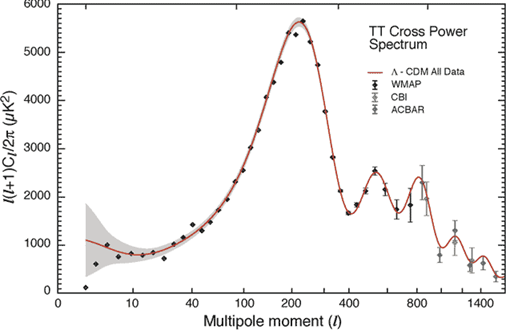
|
The diagram shows the CMB power spectrum using data from WMAP, CBI and ACBAR. Briefly explain exactly what the "CMB power spectrum" actually is and what the symbols l and Cl represent. |
[3] |
The steps you need to include are the following:
|
[2] |
| Therefore l is the index of your spherical-harmonic expansion (therefore, the larger the value of l, the smaller the angle you are talking about), and Cl is the coefficient of that component in your Legendre polynomial expansion, and therefore represents the relative strength of that particular angular size in the overall pattern. | [1] |
| Compare and contrast, carefully but without detailed mathematics, the growth of structure in a universe dominated by (i) non-baryonic cold dark matter, (ii) non-baryonic hot dark matter and (iii) baryonic matter. | [5] |
|
As with most descriptive questions, the mark scheme for this is fairly
flexible, and a variety of answers are possible. The one below covers
all the material and is properly structured – I have highlighted the
elements of comparison and contrast that are needed to answer the question –
but that doesn't mean that you would have to reproduce this word for word
to get full marks! In all three cases (compare), density fluctuations cannot possibly start to grow until the universe becomes matter dominated. However, in cases (ii) and (iii), (compare/contrast), galaxy-sized density fluctuations will still not start to grow, because they are prevented from doing so by radiation pressure – in case (iii), pressure from photons, because they couple to the baryons by electromagnetic interactions, but (contrast) in case (ii), pressure from the dark matter itself, which has a "radiation" equation of state because it is relativistic at this time. In case (iii), galaxy-sized density fluctuations will start to grow once the radiation decouples from the matter at recombination, whereas (contrast) in case (ii), the size of fluctuations that can grow will decrease gradually as the universe expands and the temperature, and therefore the velocity, of the dark matter particles decreases. |
[2] |
| The size of fluctuations that can grow is determined by the Jeans mass. For a non-relativistic gas such as case (i) or case (iii) after recombination (compare), this turns out to be about the size that presently corresponds to a dwarf galaxy, whereas (contrast) for case (ii) and case (iii) before recombination (compare), it is approximately the horizon size. | [2] |
Therefore, in summary:
|
[1] |
(2005 Resit, part of Q8.)